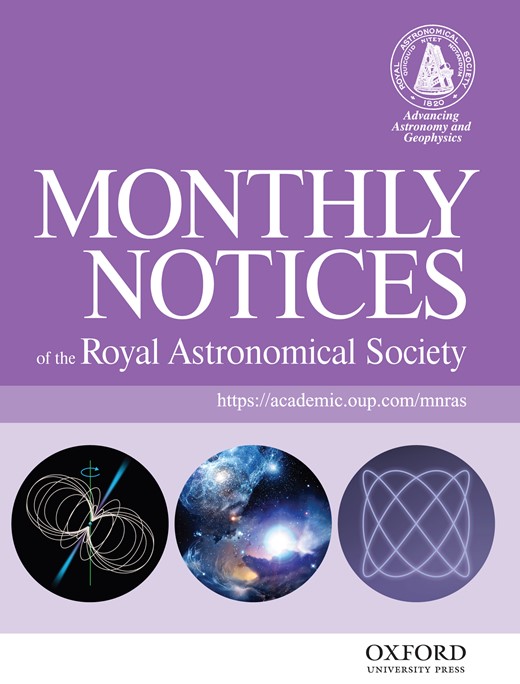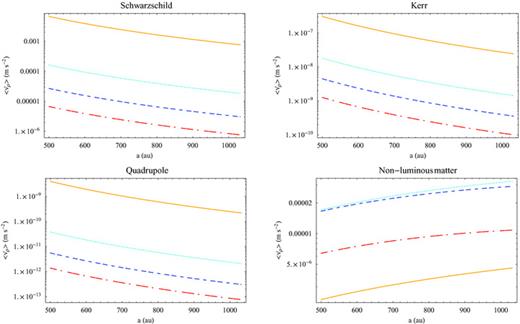-
PDF
- Split View
-
Views
-
Cite
Cite
Lorenzo Iorio, Long-term classical and general relativistic effects on the radial velocities of the stars orbiting Sgr A*, Monthly Notices of the Royal Astronomical Society, Volume 411, Issue 1, February 2011, Pages 453–463, https://doi.org/10.1111/j.1365-2966.2010.17701.x
Close - Share Icon Share
Abstract
We analytically work out the cumulative, i.e. averaged over one orbital revolution, time variations  of the radial velocity vρ of a typical S star orbiting the supermassive (M•≈ 106 M⊙) black hole (SBH) hosted by the Galactic Centre (GC) in Sgr A* caused by several dynamical effects. They are the general relativistic gravitoelectromagnetic (GEM) fields of the SBH, its quadrupole mass moment Q2 and a diffuse dark matter distribution around the SBH. All of them induce non-zero long-term radial accelerations proportional to the eccentricity e of the orbit. By taking the S2 star, orbiting the SBH along a highly eccentric (e= 0.8831) ellipse with a period Pb= 15.9 yr and semimajor axis a= 1031.69 au, we numerically compute the magnitudes of its radial accelerations. The largest effects are due to the general relativistic Schwarzschild-like gravitoelectric (GE) field, with
of the radial velocity vρ of a typical S star orbiting the supermassive (M•≈ 106 M⊙) black hole (SBH) hosted by the Galactic Centre (GC) in Sgr A* caused by several dynamical effects. They are the general relativistic gravitoelectromagnetic (GEM) fields of the SBH, its quadrupole mass moment Q2 and a diffuse dark matter distribution around the SBH. All of them induce non-zero long-term radial accelerations proportional to the eccentricity e of the orbit. By taking the S2 star, orbiting the SBH along a highly eccentric (e= 0.8831) ellipse with a period Pb= 15.9 yr and semimajor axis a= 1031.69 au, we numerically compute the magnitudes of its radial accelerations. The largest effects are due to the general relativistic Schwarzschild-like gravitoelectric (GE) field, with  , and the diffuse material distribution, modelled with a Plummer-type mass density profile, with
, and the diffuse material distribution, modelled with a Plummer-type mass density profile, with  . The effects caused by the general relativistic Kerr-type gravitomagnetic (GM) field and by Q2 are smaller by orders of magnitude. By assuming an uncertainty in measuring the radial velocities of about 15 km s−1, the future accuracy in measuring
. The effects caused by the general relativistic Kerr-type gravitomagnetic (GM) field and by Q2 are smaller by orders of magnitude. By assuming an uncertainty in measuring the radial velocities of about 15 km s−1, the future accuracy in measuring  can be evaluated to be of the order of 2.4 × 10−5 m s−2 over an observational time-span Δt= 20 yr. Currently, the available radial velocity measurements cover just 7 yr.
can be evaluated to be of the order of 2.4 × 10−5 m s−2 over an observational time-span Δt= 20 yr. Currently, the available radial velocity measurements cover just 7 yr.
1 INTRODUCTION
It is now widely accepted that the Galactic Centre (GC) hosts a supermassive black hole (SBH) (Wollman et al. 1977; Genzel et al. 1996; Schödel et al. 2002; Melia 2007; Ghez et al. 2008), whose position coincides with that of the radio-source Sagittarius A* (Sgr A*) (Reid et al. 2007). The SBH has a mass of the order of M• = 4 × 106 M⊙ (Ghez et al. 2008; Gillessen et al. 2009a,b) and, consequently, a Schwarzschild radius rg = 0.084 au. In its immediate vicinity a number of rapidly orbiting stars (Paumard et al. 2006) have been detected and tracked in the infrared since 1992 at the 8.2-m Very Large Telescope (VLT) on Cerro Paranal, Chile, and the 3.58-m New Technology Telescope (NTT) on La Silla, Chile (Eckart & Genzel 1996), and since 1995 at the Keck 10-m telescope on Mauna Kea, Hawaii (Ghez et al. 1998). They are mostly main-sequence stars of spectral class B, and are naturally used as test particles for the gravitational potential in which they move. Particularly important is the bright star S2 (S0-2 in the Keck nomenclature), of spectral type B0-2 V, orbiting the SBH in 15.9 yr along an orbit with ellipticity e = 0.8831 and semimajor axis a = 1031.69 au (Gillessen et al. 2009a). Indeed, a complete orbital revolution of it is now covered by the available data records (Gillessen et al. 2009a,b).
 of the average distance
of the average distance  to the Schwarzschild radius rg as an index of the importance of the Einstein's General Theory of Relativity (GTR) in several astronomical and astrophysical systems, it can be easily realized that the Galactic SBH, together with its stars, is, in principle, an ideal local laboratory to test GTR and other alternative theories of gravity. Indeed, by considering the Earth's artificial satellite LAGEOS (Cohen & Smith 1985), the Sun's planet Mercury, the extrasolar planet WASP-19b (Hebb et al. 2010), the double binary pulsar PSR J0737−3039A/B (Burgay et al. 2003) and the star S2 in Sgr A*, we have
to the Schwarzschild radius rg as an index of the importance of the Einstein's General Theory of Relativity (GTR) in several astronomical and astrophysical systems, it can be easily realized that the Galactic SBH, together with its stars, is, in principle, an ideal local laboratory to test GTR and other alternative theories of gravity. Indeed, by considering the Earth's artificial satellite LAGEOS (Cohen & Smith 1985), the Sun's planet Mercury, the extrasolar planet WASP-19b (Hebb et al. 2010), the double binary pulsar PSR J0737−3039A/B (Burgay et al. 2003) and the star S2 in Sgr A*, we have 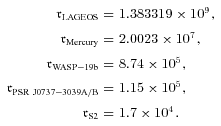
 for S2 is 1 order of magnitude smaller than that for PSR J0737−3039A/B. In this respect, several authors (Jaroszynski 1998; Fragile & Mathews 2000; Rubilar & Eckart 2001; Weinberg, Milosavljević & Ghez 2005; Kraniotis 2007; Nucita et al. 2007; Will 2008; Kannan & Saha 2009; Preto & Saha 2009; Merrit et al. 2010) worked out with a variety of techniques and approximations the direct effects of GTR on different quantities characterizing the orbital motions about the SBH, mainly some Keplerian orbital elements. If, on the one hand, they are useful to give ‘intuitive’ valuable insights about the magnitude of the relativistic effects occurring in such a scenario, on the other hand they are not directly measurable.
for S2 is 1 order of magnitude smaller than that for PSR J0737−3039A/B. In this respect, several authors (Jaroszynski 1998; Fragile & Mathews 2000; Rubilar & Eckart 2001; Weinberg, Milosavljević & Ghez 2005; Kraniotis 2007; Nucita et al. 2007; Will 2008; Kannan & Saha 2009; Preto & Saha 2009; Merrit et al. 2010) worked out with a variety of techniques and approximations the direct effects of GTR on different quantities characterizing the orbital motions about the SBH, mainly some Keplerian orbital elements. If, on the one hand, they are useful to give ‘intuitive’ valuable insights about the magnitude of the relativistic effects occurring in such a scenario, on the other hand they are not directly measurable.Concerning the motion of the S stars around the SBH in the GC, the directly observable quantities are the astrometric measurements of their positions in the sky in terms of right ascension α and declination δ, and their radial velocities vρ. Concerning the first kind of observations, according to Eisenhauer et al. (2009), future astrometric measurements of S2 may bring its relativistic perinigricon1 precession  into the measurability domain. Indeed, the perinigricon rate would be indirectly inferred from the corresponding apparent position shift. To this aim, it must also be considered that such a shift is not as easily detected as it may seem since it needs to be measured from the same data from which also the orbital elements have to be determined (Fritz et al. 2010). Thus, here we will focus on the dynamical effects directly caused by GTR and other competing classical forces on the radial velocity vρ. On the one hand, it will be possible to straightforwardly work out in an analytical way the net time variations of it averaged over one orbital revolution. This allows for a more direct and unambiguous confrontation of the theoretical predictions with the observations. On the other hand, from a practical point of view, the radial velocity data are easier to handle with respect to the astrometric observations. Indeed, the inclusion of new data into pre-existing records needs no special care because the radial velocities refer to the Local Standard of Rest (LSR) (Reid et al. 2009). Instead, for the astrometric data it turns out that only an approximate realization of a common relative reference frame is possible. It implies that the exact definition of the coordinates is a matter of each data analysis in such a way that simply merging two different sets of astrometric positions would yield incorrect results (Gillessen et al. 2009b).
into the measurability domain. Indeed, the perinigricon rate would be indirectly inferred from the corresponding apparent position shift. To this aim, it must also be considered that such a shift is not as easily detected as it may seem since it needs to be measured from the same data from which also the orbital elements have to be determined (Fritz et al. 2010). Thus, here we will focus on the dynamical effects directly caused by GTR and other competing classical forces on the radial velocity vρ. On the one hand, it will be possible to straightforwardly work out in an analytical way the net time variations of it averaged over one orbital revolution. This allows for a more direct and unambiguous confrontation of the theoretical predictions with the observations. On the other hand, from a practical point of view, the radial velocity data are easier to handle with respect to the astrometric observations. Indeed, the inclusion of new data into pre-existing records needs no special care because the radial velocities refer to the Local Standard of Rest (LSR) (Reid et al. 2009). Instead, for the astrometric data it turns out that only an approximate realization of a common relative reference frame is possible. It implies that the exact definition of the coordinates is a matter of each data analysis in such a way that simply merging two different sets of astrometric positions would yield incorrect results (Gillessen et al. 2009b).
 . Then, we straightforwardly compute its secular variation as the sum of two parts. The first one is purely Keplerian, and it vanishes over one orbital period Pb. The second one is due to the non-Keplerian variations of all the orbital elements induced by the dynamical perturbation considered. The total result is, thus,
. Then, we straightforwardly compute its secular variation as the sum of two parts. The first one is purely Keplerian, and it vanishes over one orbital period Pb. The second one is due to the non-Keplerian variations of all the orbital elements induced by the dynamical perturbation considered. The total result is, thus, 
 and d κ/d t are the instantaneous variations2 of the Keplerian orbital elements computed with, e.g. the Gauss variation equations and evaluated on to the unperturbed Keplerian ellipse, while
and d κ/d t are the instantaneous variations2 of the Keplerian orbital elements computed with, e.g. the Gauss variation equations and evaluated on to the unperturbed Keplerian ellipse, while  and dt/df are the usual Keplerian expressions for such derivatives: see equations (10) and (11) below.
and dt/df are the usual Keplerian expressions for such derivatives: see equations (10) and (11) below.The paper is organized as follows. In Section 2 we deal with some kinds of both classical and relativistic perturbing accelerations. The long-term effects caused by them on the radial velocity are analytically worked out in Section 3. In Section 4 we perform numerical calculations by using the S2 star, and confront them with the present-day measurement accuracy. Section 5 is devoted to summarizing our findings.
2 THE PERTURBING ACCELERATIONS
2.1 General treatment and overview
Here we deal with a generic perturbing acceleration A induced by a given dynamical effect which can be considered as small with respect to the main Newtonian monopole ANewton=GM•/r2, where G is the Newtonian constant of gravitation and r is the relative star–SBH distance. The stars orbiting the SBH are assumed to be the test particles: their masses are about m★≲ 10−5M•, and relativistic corrections to their internal structures are assumed to be too small to yield noticeable effects on their orbital motions.
 of the comoving frame of the test particle orbiting the central body acting as the source of the gravitational field. Their components, in cartesian coordinates of a reference frame centred in the primary, are (Montenbruck & Gill 2000)
of the comoving frame of the test particle orbiting the central body acting as the source of the gravitational field. Their components, in cartesian coordinates of a reference frame centred in the primary, are (Montenbruck & Gill 2000) 


 of the line of sight, pointing from the object to the observer, to be directed along the positive z axis, so that the {xy} plane coincides with the usual plane of the sky. With such a choice, corresponding to the frame actually used in data reduction (Ghez et al. 2008), λ is the familiar i and Ω is an angle in the plane of the sky counted from the mean vernal point at J2000 epoch along which the reference x axis is customarily chosen; it is such a node which is actually determined from the observations (Ghez et al. 2008; Gillessen et al. 2009a,b). In other cases, in order to compute more easily certain dynamical perturbations, we will orient our frame with the z-axis aligned with the central body's proper angular momentum L, so that the reference {xy} plane will coincide with the body's equatorial plane. In this case, Ω will be an angle lying in such a plane, and it is not the one released in literature (Ghez et al. 2008; Gillessen et al. 2009a,b). Moreover, u≐f+ω is the argument of latitude. Subsequently, the projected components of A have to be evaluated for the Keplerian ellipse:
of the line of sight, pointing from the object to the observer, to be directed along the positive z axis, so that the {xy} plane coincides with the usual plane of the sky. With such a choice, corresponding to the frame actually used in data reduction (Ghez et al. 2008), λ is the familiar i and Ω is an angle in the plane of the sky counted from the mean vernal point at J2000 epoch along which the reference x axis is customarily chosen; it is such a node which is actually determined from the observations (Ghez et al. 2008; Gillessen et al. 2009a,b). In other cases, in order to compute more easily certain dynamical perturbations, we will orient our frame with the z-axis aligned with the central body's proper angular momentum L, so that the reference {xy} plane will coincide with the body's equatorial plane. In this case, Ω will be an angle lying in such a plane, and it is not the one released in literature (Ghez et al. 2008; Gillessen et al. 2009a,b). Moreover, u≐f+ω is the argument of latitude. Subsequently, the projected components of A have to be evaluated for the Keplerian ellipse: 


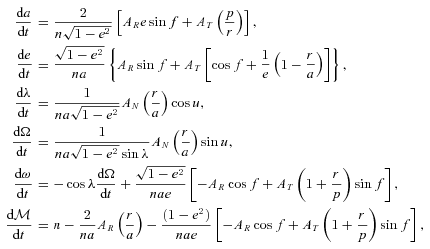
 is the Keplerian mean motion related to the orbital period by n = 2π/Pb.
is the Keplerian mean motion related to the orbital period by n = 2π/Pb.

2.2 The effect of general relativity





2.2.1 The gravitoelectric, Schwarzschild-like perturbation


 , so that
, so that  . Moreover, equation (18) does not depend on the inclination of the orbit to the plane of the sky.
. Moreover, equation (18) does not depend on the inclination of the orbit to the plane of the sky.2.2.2 The gravitomagnetic, Lense–Thirring-like perturbation



2.3 The quadrupole mass moment

 is the unit vector of the body's angular momentum, directed here along the positive z axis so that the equatorial plane is the reference {xy} plane (again, λ→Ψ). According to equations (3)–(5) and equation (7), the R–T–N components of equation (22) are
is the unit vector of the body's angular momentum, directed here along the positive z axis so that the equatorial plane is the reference {xy} plane (again, λ→Ψ). According to equations (3)–(5) and equation (7), the R–T–N components of equation (22) are 




 from the dedicated GRACE spacecraft (Bruinsma et al. 2010), respectively.
from the dedicated GRACE spacecraft (Bruinsma et al. 2010), respectively.2.4 Inner diffuse mass distribution
It is well recognized that, in addition to the dynamical effects considered so far directly related to the SBH, the impact of a diffuse cluster of non-luminous ordinary matter5 around the BH due to massive remnants of various kinds (Morris 1993) should also be taken into account. Indeed, reasoning in terms of the perinigricon, such an extended material component would induce a retrograde precession  which may overwhelm the general relativistic GE one for certain values of its mass (Rubilar & Eckart 2001). Let us, now, work out in detail its dynamical effects.
which may overwhelm the general relativistic GE one for certain values of its mass (Rubilar & Eckart 2001). Let us, now, work out in detail its dynamical effects.


 at a given distance
at a given distance  to the central point mass. Gillessen et al. (2009b), with a fit involving S2 is able to probe the mass enclosed between its aponigricon and perinigricon, yield
to the central point mass. Gillessen et al. (2009b), with a fit involving S2 is able to probe the mass enclosed between its aponigricon and perinigricon, yield 


 , written in spherical coordinates since
, written in spherical coordinates since  in view of the fact that ϱ=ϱ(r), the perturbing acceleration
in view of the fact that ϱ=ϱ(r), the perturbing acceleration 
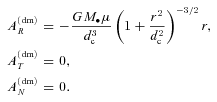
3 THE RADIAL VELOCITY
 has been assumed to be directed along the z axis. Concerning the S stars orbiting the Galactic SBH, let us mention the possibility that some of them may actually be binaries themselves. In this case, additional ‘noise’ to the radial velocity data would be introduced. Its expression for unperturbed, Keplerian elliptic orbits, up to the velocity of the system's centre of mass v0, can be obtained by using the z components of equations (3) and (4) with λ→i, and recalling that, for a Keplerian orbit (Roy 2005),
has been assumed to be directed along the z axis. Concerning the S stars orbiting the Galactic SBH, let us mention the possibility that some of them may actually be binaries themselves. In this case, additional ‘noise’ to the radial velocity data would be introduced. Its expression for unperturbed, Keplerian elliptic orbits, up to the velocity of the system's centre of mass v0, can be obtained by using the z components of equations (3) and (4) with λ→i, and recalling that, for a Keplerian orbit (Roy 2005), 


 of the orbital angular momentum and the unit vector
of the orbital angular momentum and the unit vector  of the line of sight pointing towards the observer. From the spherical law of cosines (Gellert et al. 1989; Zwillinger 1995)
of the line of sight pointing towards the observer. From the spherical law of cosines (Gellert et al. 1989; Zwillinger 1995) 

 and the unit vector
and the unit vector  of the central body's proper angular momentum, I is the angle between
of the central body's proper angular momentum, I is the angle between  and
and  and Ω is the longitude of the ascending node defined from
and Ω is the longitude of the ascending node defined from 

3.1 The effect of general relativity



Some preliminary and approximate calculation of the effects of both the general relativistic GEM dynamical effects on the velocity of S stars orbiting the SBH in GC can be found in Kannan & Saha (2009); they deal neither with the directly measurable radial velocity nor with its possible variations. See also Angélil & Saha (2010) for GEM effects on the traveling photons paths.
Special relativistic effects on the radial velocity related to the Doppler effect have been considered by Zucker et al. (2006); anyway, they do not involve net variations of vρ over one orbital revolution.
3.2 The quadrupole mass moment


3.3 The diffuse inner dark matter
 can be worked out from equation (34). An approximate calculation with
can be worked out from equation (34). An approximate calculation with 



4 NUMERICAL EVALUATIONS AND CONFRONTATION WITH THE MEASUREMENT ACCURACY
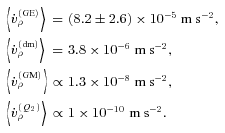
 may be assumed in future over an observational time-span Δt = 20 yr. Actually, it must be pointed out that the currently available radial velocity measurements do not yet cover one full orbit revolution for S2. Indeed, the first radial velocity data points are from 2000, then 2002; they are more densely sampled from 2003 onwards (S. Gillessen, private communication, August 2010).
may be assumed in future over an observational time-span Δt = 20 yr. Actually, it must be pointed out that the currently available radial velocity measurements do not yet cover one full orbit revolution for S2. Indeed, the first radial velocity data points are from 2000, then 2002; they are more densely sampled from 2003 onwards (S. Gillessen, private communication, August 2010).It has to be pointed out that the total accuracy reachable in the changes in the radial velocities is actually impacted by the uncertainty in LSR itself. Indeed, as explained by Ghez et al. (2008), to obtain the radial velocities with respect to the LSR, each observed radial velocity has to be corrected for the Earth's rotation, its motion around the Sun and the Sun's peculiar motion with respect to the LSR (nominal value U⊙ = 10 km s−1, directed radially inwards; Dehnen & Binney 1998). Since the LSR is defined as the velocity of an object in circular orbit at the radius of the Sun, the Sun's peculiar motion with respect to the average velocity of stars in its vicinity should give the Sun's motion toward the GC. In all such machineries, also the rotation speed Θ0 of LSR enters; recent evaluations by Reid et al. (2009) yield an uncertainty of the order of 16 km s−1 corresponding to a future uncertainty of 2 × 10−5 m s−2 over Δt = 20 yr. Moreover, also the motion of the SBH itself should be taken into account (Ghez et al. 2008). In particular, the uncertainty in its radial velocity can be evaluated to be 2 km s−1 (Gould 2004) implying a limit in the accuracy in  of about 1 × 10−6 m s−2 over Δt = 20 yr. Such limiting factors should be taken into account when future improvements in measuring radial velocities are discussed. Searches for pulsars orbiting the SBH are currently underway (Macquart et al. 2010); their discovery may yield orbiting probes with a better accuracy in their radial velocity changes.
of about 1 × 10−6 m s−2 over Δt = 20 yr. Such limiting factors should be taken into account when future improvements in measuring radial velocities are discussed. Searches for pulsars orbiting the SBH are currently underway (Macquart et al. 2010); their discovery may yield orbiting probes with a better accuracy in their radial velocity changes.
These considerations show that while the gravitomagnetic and the quadrupole effects are far from being directly detectable in such a way, the gravitoelectric trend lies just at the edge of the measurability capabilities. The effect of the diffuse dark matter inside the orbit of S2 is 1 order of magnitude smaller than the general relativistic GE one. Incidentally, such figures indicate that higher-order corrections to the computed effects of equations (42)–(43) in the linear GEM approximation due to the relativistic motion of S2 can be neglected at the moment.
Finally, in view of the possible discovery in the near future of stars closer than S2, we plot in Fig. 1 the magnitudes of the effects considered as functions of the semimajor axis for different values of the eccentricity.
Maximum values of the long-term time variations  , in m s−2, as a function of a (500 au ≤a≤ 1031.69 au) for different values of the eccentricity: e = 0.1 (red dash–dotted line), e = 0.3 (blue dashed line), e = 0.6 (light blue dotted line), e = 0.9 (yellow continuous line). For the spin L• and the quadrupole Q•2 of the SBH, we used the values of equations (15) and (26), respectively.
, in m s−2, as a function of a (500 au ≤a≤ 1031.69 au) for different values of the eccentricity: e = 0.1 (red dash–dotted line), e = 0.3 (blue dashed line), e = 0.6 (light blue dotted line), e = 0.9 (yellow continuous line). For the spin L• and the quadrupole Q•2 of the SBH, we used the values of equations (15) and (26), respectively.
5 CONCLUSIONS
One of the directly measurable quantities of the system constituted by the S stars orbiting the supermassive black hole located at the centre of the Milky Way in the radio source Sgr A* is the radial velocity. Given that S2 has already completed one full orbital revolution, with a period of 15.9 yr, since its discovery, and in view of the possible detection in the near future of other stars and pulsars with shorter orbital periods, we looked at the cumulative, long-term time variations of the radial velocity caused by several Newtonian and Einsteinian dynamical effects. They are both the general relativistic Schwarzschild and Kerr-like components of the space–time metric, the quadrupole mass moment and the diffuse dark mass distribution made by stellar remnants enclosed within the star's orbit. We analytically worked out the long-term variations in the radial velocity induced by them by finding non-zero effects for all of them. We used S2 for numerically computing their magnitudes. They are 8 × 10−5 m s−2 (Schwarzschild), 4 × 10−6 m s−2 (dark matter), 1 × 10−8 m s−2 (Kerr) and 1 × 10−10 m s−2 (quadrupole), respectively. In computing the general relativistic variations of the radial velocity, we remained within the post-Newtonian regime by neglecting relativistic corrections of higher order in the equations of motion. The figures for the Kerr and quadrupole effects have been computed by using the latest determinations of the angular momentum parameter of the Galactic black hole, and in the ‘no-hair’ hypothesis, respectively. For the dark matter distribution we used a Plummer-like mass density profile. By assuming a present-day uncertainty of about 15 km s−1 in the radial velocity measurements, its time changes may be detected in the future at a ≈ 10−5 m s−2 level over an observational time-span of 20 yr; at present, radial velocity data cover just 7 yr. Even if such evaluations will turn out to be not too optimistic, a detection of the Kerr and the quadrupole-induced cumulative changes of the radial velocity seems to be unfeasible.
Schödel et al. (2002) introduced in the scientific literature for the first time such a term for designing the pericentre ω in the case of a BH. It comes from the Latin word ‘niger’, meaning ‘black’. Before, the term ‘perimelasma’ was used by the physicist G. A. Landis (2001) in a science-fiction tale of him. Actually, the Greek word ‘ ’ means ‘black’, but, on the other hand, ‘melasma’ (Chloasma faciei) is a medical term for a skin disease in which skin turns tan or dark. An earlier and somewhat more adequate term is ‘peribothron’, coming from the Greek word ‘
’ means ‘black’, but, on the other hand, ‘melasma’ (Chloasma faciei) is a medical term for a skin disease in which skin turns tan or dark. An earlier and somewhat more adequate term is ‘peribothron’, coming from the Greek word ‘ ’ for ‘pit’. It comes from a suggestion by W. R. Stoeger to Frank & Rees (1976). After all, BHs may not be entirely ‘black’ since, under certain circumstances, they may radiate, so that a term recalling their deep gravitational well appears more suitable to characterize them. It is notable that Soviet scholars had previously defined BHs as ‘frozen stars’, which might have given origin to the word ‘peripekton’ from the Greek word ‘
’ for ‘pit’. It comes from a suggestion by W. R. Stoeger to Frank & Rees (1976). After all, BHs may not be entirely ‘black’ since, under certain circumstances, they may radiate, so that a term recalling their deep gravitational well appears more suitable to characterize them. It is notable that Soviet scholars had previously defined BHs as ‘frozen stars’, which might have given origin to the word ‘peripekton’ from the Greek word ‘ ’ for ‘frozen’.
’ for ‘frozen’.
Actually,  is the sum of the Keplerian mean motion n and a non-Keplerian term, as we will see later. Its Keplerian part yields from equation (2) the Keplerian variation of Y.
is the sum of the Keplerian mean motion n and a non-Keplerian term, as we will see later. Its Keplerian part yields from equation (2) the Keplerian variation of Y.
It is an angle in the reference {xy} plane from the reference x direction to the line of the nodes.
It is the intersection of the orbital plane with the reference plane {xy}.
In principle, one should also take into account the issue of non-baryonic dark matter cusps in relation to the merging history of galaxies (Merritt & Milosavljević 2002). But it is beyond the scope of this work.
In such a way, Ω results to be prograde with respect to the orbital motion, i.e. Ω follows it, coherently with the definition of the longitude of ascending node. Moreover, it lies in the equatorial plane.
It is assumed that the orbital motion is prograde with respect to the BH's spin; a − sign would occur in the opposite case.
In principle, spherical trigonometric formulas relate the two nodes Ωe and Ωs, where e and s denote the equator and the sky, respectively. However, knowledge of the angle, in the plane of the sky, between the equatorial plane and the reference {xz} plane, would be required.
The effects of non-baryonic dark matter on the perinigricon precession have been considered by e.g. Zakharov et al. (2007).
The figures for  and
and  refer to the dimensional multiplicative factors in front of the square brackets in equation (43) and in equation (45).
refer to the dimensional multiplicative factors in front of the square brackets in equation (43) and in equation (45).
I thank S. Gillessen for useful information about the radial velocity and QPOs. I am also grateful to an anonymous referee for her/his useful comments which improved the manuscript.
REFERENCES


